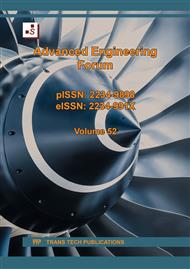[1]
M. Panagiotis, Modeling and Optimization of a Hydroelectric Power Plant for a National Grid Power System Supply, Case Study: Stratos Hydroelectric Dam, Journal of Power and Energy Engineering, (2020) Vol.8 No.8.
Google Scholar
[2]
S. L. Gbadamosi and A. Ojo, Dynamic Modeling and Simulation of Shiroro Hydro Power Plant in Nigeria using MATLAB/SIMULINK, International Journal of Scientific and Engineering Research, (2015) vol.6, no. 8, p.948.
Google Scholar
[3]
A. O. Melodi, Analysis of Generating Capacity Dynamics of the Nigerian Power System between 1963 and 2020, Advanced Materials Research (Vols. 62-64), (2009) pp.114-119.
DOI: 10.4028/www.scientific.net/amr.62-64.114
Google Scholar
[4]
A. O. Melodi, J. A. Momoh and O. M. Adeyanju, Nigerian 330 kV 38 bus Transmission Network 10-year Expansion Planning under Probabilistic Load Forecasts, Journal of Electrical Engineering, (2018) vol. 100, no. 4, pp.2717-2724.
DOI: 10.1007/s00202-018-0735-3
Google Scholar
[5]
Mathworks, "Products and Services," The MathWorks, Inc., 19 9 2023. [Online]. Available: https://www.mathworks.com/products.html?s_tid=gn_ps. [Accessed 19 9 2023].
Google Scholar
[6]
X.-F. Wang, Y. Song and M. Irving, Modern Power Systems Analysis, New York: Springer, (2008).
DOI: 10.1007/978-0-387-72853-7
Google Scholar
[7]
G. A. Munoz-Hernandez and D. I. Jones, "Modeling, Simulation and Control of a Hydroelectric Pumped Storage Power Station," University of Bath, Bath, United Kingdom, 2004
DOI: 10.1109/CONIEL.2005.49
Google Scholar
[8]
G. Singh and D. S. Chauhan, "Simulation and Modeling of Hydro Power Plant to Study Time Response during Different Gate States," International Journal of Advanced Engineering Sciences and Technologies (IJAEST), (2011) vol.10, issue no.1, pp.42-47.
Google Scholar
[9]
G. A. M. Hernandez, S. P. Mansoor and D. L. Jones, Modeling and Controlling Hydro Power Plant, London: Springer, 2013
DOI: 10.1007/978-1-4471-2291-3
Google Scholar
[10]
P. Sridhar and K. B. Prasad, Fault Analysis in Hydro Power Plant Using Matlab / Simulink, International Journal of Electrical Engineering and Technology, (2014) vol. 5, no. 5, pp.89-99.
Google Scholar
[11]
M. Saunders, P. Lewis, and A. Thornhill, Research Methods for Business Students, sixth ed., Pearson Education Limited, Harlow, 2012.
Google Scholar
[12]
M. Singh and A. Chandra, Modeling and Control of Isolated Micro-Hydro Power Plant with Battery Storage System, National Power Electronic Conference, Roorkee, India. International Journal of Computer Applications, (2010) 108(18): 0975 - 8887
DOI: 10.5120/19014-0541
Google Scholar
[13]
V. D. Vournas, Second order hydraulic turbine models for multi-machine stability studies, IEEE Trans Energy Conv 1990; (2007) 5: pp.239-244.
DOI: 10.1109/60.107216
Google Scholar
[14]
T.S. Abdulkadir, A. W. Salami, A. R. Anwar, and A. G. Kareem, Modelling of Hydropower Reservoir Variables for Energy Generation: Neural Network Approach, Ethiopian Journal of Environmental Studies, and Management (2013) Vol. 6 No.3.
DOI: 10.4314/ejesm.v6i3.12
Google Scholar
[15]
D.G. Ramey and J.W. Skooglund, Detailed Hydro Governor Representation for System Stability studies. IEEE Trans on Power Apparatus and Systems, (1970) 89:106-112.
DOI: 10.1109/TPAS.1970.292676
Google Scholar
[16]
A.W. Salami and B. F. Sule, Optimal Water Management Modeling for Hydro Power System on River Niger in Nigeria, Annals of Faculty Engineering, International Journal of Engineering, Tome X, Fascicule 1, Hunedoara, Romania, (2012) (ISSN 1584-2665) pp.185-192,.
Google Scholar
[17]
H. Algarvio, F. Lopes, and J. Santana, Strategic Operation of Hydroelectric Power Plants in Energy Markets: A Model and a Study on the Hydro-Wind Balance: A Model and a Study on the Hydro-Wind Balance. Fluids (2020) 5, 209.
DOI: 10.3390/fluids5040209
Google Scholar
[18]
G. Shahgholian, An Overview of Hydroelectric Power Plant: Operation, Modeling, and Control. Journal of Renewable Energy and Environment, (2020), 7(3), 14-28. https://doi.org/.
Google Scholar
[19]
V. Nikitin, N. Abasov and E. Osipchuk, Modeling of Long-term Operating Regimes of Hydro Power Plants as Part of Energy and Water Systems in the Context of Uncertainty, E3S Web Conf., 209 (2020) 05014.
DOI: 10.1051/e3sconf/202020905014
Google Scholar


